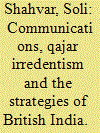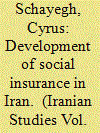|
|
|
Sort Order |
|
|
|
Items / Page
|
|
|
|
|
|
|
| Srl | Item |
| 1 |
ID:
075608


|
|
|
|
|
| Publication |
2006.
|
| Summary/Abstract |
After emigrating from Ottoman territory to Safavid Iran in the mid-sixteenth century, the Shiite scholar Husayn b. 'Abd al-Samad al-'Amili wrote an eloquent letter-cum-travel account describing his experiences to his teacher Zayn al-Din al-'Amili who had remained in Jabal 'Amil. A manuscript of this fascinating document has now come to light and been edited twice, in 2001 and 2003. An analysis of the undated letter shows that it was written in 961/1554 and describes a journey that occurred earlier that same year. Husayn's statements do not spell out the exact cause of his flight from Ottoman territory but suggest that he was wary of being denounced to the authorities and felt that his academic career was severely limited there. He evidently supported Safavid legitimacy wholeheartedly, though he harbored misgivings about the moral environment in Iran and had sharp criticisms for Persian religious officials
|
|
|
|
|
|
|
|
|
|
|
|
|
|
|
|
| 2 |
ID:
075610


|
|
|
|
|
| Publication |
2006.
|
| Summary/Abstract |
Persian territorial designs in Baluchistan clashed with British interest to construct an Indo-European telegraph line through the Makran Coast, where Britain had close local allies in dispute with Persia. The British prime interest being the speedy construction of the line, they decided on bypassing these disputed territories by connecting Bushehr, through submarine cable, with Gwadar-which they believed, contrary to the Persians, to be non-Persian. The Persian government protested against the British infringement of her sovereign rights, adopting both diplomatic and military approaches. This forced the British government to check the legality of the Persian claims. But the arbitrary was neither neutral nor fair, with Britain opposing the suzerainty of Persia over the chiefs of western Makran, while acknowledging the right of conquest by others elsewhere on the coast. This was in line with British policy of favoring governments bordering British India over Persia. Although unable to change the arbitrary, the Persian government still managed, in spite of her military weakness, to drag the British government into a hard bargain and tough negotiations.
|
|
|
|
|
|
|
|
|
|
|
|
|
|
|
|
| 3 |
ID:
075609


|
|
|
|
|
| Publication |
2006.
|
| Summary/Abstract |
This text brings the case of Iranian social insurance (SI) to bear on the processes shaping Iranian politics from 1941 to 1960. It holds that the political needs of upper class rule (1941-51) and of the early autocratic regime (1953-1960) helped to shape SI's nature, extent, and limits. A key objective was to propagandistically use a minimal version of SI to try undermining communist and workers' trade unionist agitation. Iranian SI had two rationales. Although a few workers demanded SI measures during the Constitutional Revolution, the first SI program (1922, 1931, 1933) covered government employees, i.e. was a function of state-building. This paper focuses on a second program, targeting non-government workers. Starting in 1936 (1943, 1949), it was meant to tackle the social and political challenges posed by a nascent industrial working class. However, throughout the 1940s, workers' SI laws remained a dead letter, and the first integrated SI bureaucracy (1953), although ensuring 180,000 people, was in reality quite inefficient.
|
|
|
|
|
|
|
|
|
|
|
|
|
|
|
|
|
|
|
|
|